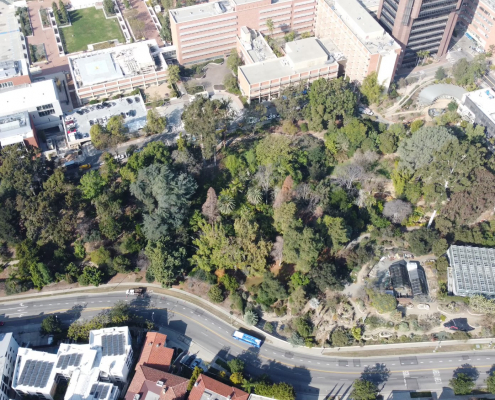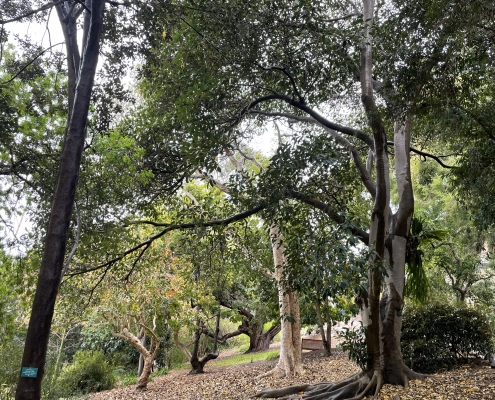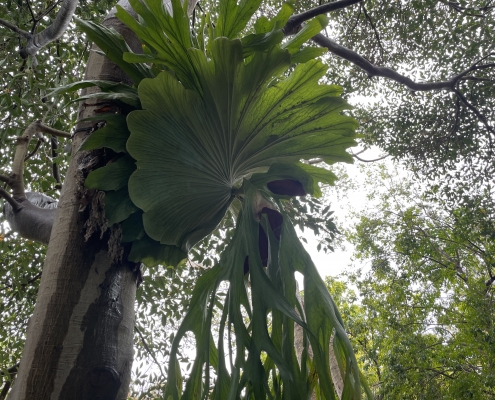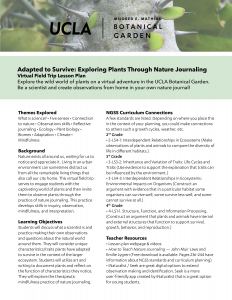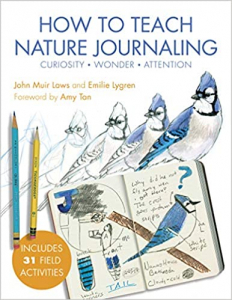Overview
Adapted to Survive: Exploring Plants through Nature Journaling
Explore the wild world of plants on a virtual adventure in the UCLA Botanical Garden. Be a scientist and create observations from home in your own nature journal!
Background
Nature exists all around us, waiting for us to notice and appreciate it. Living in an urban environment can sometimes distract us from all the remarkable living things that also call our city home. This virtual field trip serves to engage students with the captivating world of plants and then invite them to observe plants through the practice of nature journaling. This practice develops skills in inquiry, observation, mindfulness, and interpretation.
Learning Objectives
Students will discuss what a scientist is and practice making their own observations and questions about the natural world around them. They will consider unique characteristics/traits plants have adapted to survive in the context of the larger ecosystem. Students will utilize art and writing to document plants and reflect on the function of characteristics they notice. They will explore the therapeutic mindfulness practice of nature journaling.
Themes/Topics Explored
What is science? • Five senses • Connection to nature • Observations skills • Reflective journaling • Ecology • Plant biology • Biomes • Adaptation • Mindfulness
Student Materials
• Access to internet connection and a device to join the class
• Paper
• Writing utensil (pencil, colored pencils)
Teacher Lesson Plan
Download a PDF lesson plan here.
NGSS
Curriculum Connections — Next Generation Science Standards (NGSS)
A few standards are listed. Depending on where you place this in the context of your planning, you could make connections to others such a growth cycles, weather, etc.
2nd Grade
2-LS4-1: Interdependent Relationships in Ecosystems. Make observations of plants and animals to compare the diversity of life in different habitats. [Clarification Statement: Emphasis is on the diversity of living things in each of a variety of different habitats.] [Assessment Boundary: Assessment does not include specific animal and plant names in specific habitats.]
3rd Grade
3-LS3-2: Inheritance and Variation of Traits: Life Cycles and Traits. Use evidence to support the explanation that traits can be influenced by the environment. [Clarification Statement: Examples of the environment affecting a trait could include normally tall plants grown with insufficient water are stunted; and, a pet dog that is given too much food and little exercise may become overweight.]
3-LS4-3: Interdependent Relationships in Ecosystems: Environmental Impacts on Organisms. Construct an argument with evidence that in a particular habitat some organisms can survive well, some survive less well, and some cannot survive at all. [Clarification Statement: Examples of evidence could include needs and characteristics of the organisms and habitats involved. The organisms and their habitat make up a system in which the parts depend on each other.]
4th Grade
4-LS1-1. Structure, Function, and Information Processing. Construct an argument that plants and animals have internal and external structures that function to support survival, growth, behavior, and reproduction. [Clarification Statement: Examples of structures could include thorns, stems, roots, colored petals, heart, stomach, lung, brain, and skin.] [Assessment Boundary: Assessment is limited to macroscopic structures within plant and animal systems.]
Format
This 50min – one hour session is led by a Garden Educator. The teacher must be present, but does not need to lead any portions of the lesson other than coordinating technology.
1. Live: Introduce Garden Educator to Classroom (5 min)
2. Video: Welcome! (2 min)
Start video. Pause when prompted.
3. Live: Garden Educator Discussion + Virtual Adventure Introduction (5 min)
4. Video: Botanical Garden Adventure (15 min)
Play video tour (Intro, California Native Plants, Desert, Tropical Rainforest)
5. Live: Q&A Session with a Garden Educator (8 min) + Nature Journaling Activity (15 min)
(50 min total)
Virtual Garden Adventure Video
Activity: Zoom In, Zoom Out
Record observations at 4 scales: Far Away, Landscape, Life Size, and Close Up
(Click on an image and share with the class for 1.5 minutes at each scale)
Use circles to show magnified views for the “zoom in.” In the zoomed-out view, you can include details such as growth forms, where the subject is, or a small map.
Use writing, drawing, and numbers to record your observations.
Share drawings, questions, and ideas with the Garden Educator.
The plant featured in these photos is a Staghorn fern, Platycerium superbum. It is native to Australia.
Teacher Resources
Teacher Lesson Plan
Download a PDF lesson plan here.
How to Teach Nature Journaling
by John Muir Laws and Emilie Lygren
A free download of the book is available. Pages 236-244 have information about NGSS standards and incorporating nature journaling into your curriculum planning.
Great digital apps with activity options to extend observation making and identification. Here is a great teacher resource guide to get started. Seek is a more child-friendly app created by iNaturalist.


